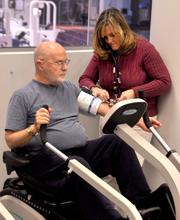Cardiac Rehabilitation - Phase II
Appointment-Cardiac Rehab at 90 Presidential Plaza, Room 5156, Syracuse, NY 13202
Hours: Monday-Friday, 7:30am-2pm
Phone: 315 464-8369
Fax: 315 464-5459

Cardiac Rehabilitation at Upstate is considered a hospital based out-patient Phase II cardiac rehabilitation program. It is designed to return patients with heart disease to active and productive lives by helping them to regain strength and to educate patients about exercise, diet, tobacco use, stress relief and other healthy lifestyle measures.
Cardiac Rehab-Phase II is a supervised monitored exercise program, and includes education on cardiac risk factors. A patients individual exercise program will be supervised and monitored by the cardiac team; a team of healthcare professionals such as a physician, nurse, and physical therapist. Patients will be on a heart monitor while they exercise, and their blood pressure and physical exertion will also be monitored. Our cardiac rehabilitation team works with each patient closely, assisting each patient in setting personalized goals and monitoring their progress.
The exercise training sessions are group classes three days a week and are usually an hour long. During the cardiac rehabilitation program patients will exercise using machines such as a treadmill, step machine or bike. The program usually lasts for 12 weeks. There is also an education class once a week directly following the exercise class.
Phase II Cardiac rehabilitation is offered at Upstate Medical University's state-of-the-art Institute of Human Performance (IHP). This facility with nearby parking lot is just two blocks from University Hospital.
Participants need a physicians referral (usually their cardiologists) to begin a Cardiac Rehab Program. Most health insurance plans, including Medicare will pay for some of the cost of Cardiac Rehabilitation (Phase II) for patients:
- Who begin the program within 12 months after a heart attack
- Who had coronary artery bypass surgery
- With chronic stable angina
- Who had heart valve repair or replacement
- Who had coronary angioplasty or coronary stenting
- Who had a heart or heart/lung transplant
